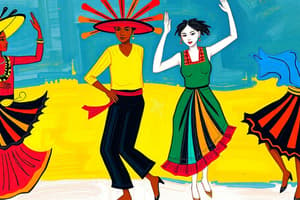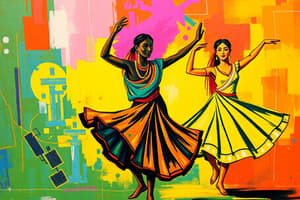Podcast
Questions and Answers
What mimetic action does Itik-itik primarily portray?
What mimetic action does Itik-itik primarily portray?
- The grace of fish
- The motion of crabs
- The flight of birds
- The movement of ducks (correct)
In the dance Sayaw sa Bangko, how do the dancers interact with each other?
In the dance Sayaw sa Bangko, how do the dancers interact with each other?
- They compete against each other
- They complement each other's movements (correct)
- They execute group formations
- They perform choreographed routines separately
What is the primary setting in which the Kuratsa dance is typically performed?
What is the primary setting in which the Kuratsa dance is typically performed?
- Religious ceremonies
- Funerals and wakes
- School events and competitions
- Weddings and social occasions (correct)
What characterizes the structure of the Kuratsa dance?
What characterizes the structure of the Kuratsa dance?
What inspired the creation of Itik-itik according to its history?
What inspired the creation of Itik-itik according to its history?
What is a common theme explored in contemporary dance in the Philippines?
What is a common theme explored in contemporary dance in the Philippines?
Which dance is characterized by male dancers hitting coconut shell halves?
Which dance is characterized by male dancers hitting coconut shell halves?
Which form of dance in the Philippines is recognized for being collective and created by ordinary people?
Which form of dance in the Philippines is recognized for being collective and created by ordinary people?
What distinguishes the Pandanggo sa Ilaw dance?
What distinguishes the Pandanggo sa Ilaw dance?
What factor contributes to the diversity of dances in the Philippines?
What factor contributes to the diversity of dances in the Philippines?
In which region did the Pandanggo sa Ilaw originate?
In which region did the Pandanggo sa Ilaw originate?
Which of the following dances is specifically mentioned as having roots in Spanish influence?
Which of the following dances is specifically mentioned as having roots in Spanish influence?
What is a key feature of the Maglalatik dance attire?
What is a key feature of the Maglalatik dance attire?
What is the primary characteristic of the Tinikling dance?
What is the primary characteristic of the Tinikling dance?
Which dance is based on the ancient Hindu epic, the Ramayana?
Which dance is based on the ancient Hindu epic, the Ramayana?
What does the term 'Cariñosa' mean in English?
What does the term 'Cariñosa' mean in English?
In which region did the Binasuan dance originate?
In which region did the Binasuan dance originate?
What is the primary skill required to perform Tinikling?
What is the primary skill required to perform Tinikling?
What does the performance of Singkil symbolize?
What does the performance of Singkil symbolize?
What type of events is the Binasuan dance typically performed at?
What type of events is the Binasuan dance typically performed at?
Which attire is commonly associated with the Cariñosa dance?
Which attire is commonly associated with the Cariñosa dance?
Flashcards are hidden until you start studying
Study Notes
Contemporary Dance in the Philippines
- Contemporary dance in the Philippines often explores themes of identity, culture, and social issues.
- This form of dance incorporates elements of traditional Filipino dance and music.
- Contemporary dance in the Philippines is dynamic and expressive, and it is gaining popularity both in the Philippines and internationally.
Philippine Folk Dance
- The diverse dances of the Philippines reflect different cultural contexts and experiences.
- Many dances from the mountains are inspired by the landscape and birds.
- Folk dances in the Philippines vary based on regional customs, traditions, and languages.
- The country has a Muslim population in Mindanao and the Sulu archipelago, as well as over 50 ethnolinguistic groups or tribes that contribute to the diverse dance forms.
Forms of Philippine Folk Dances
- Folk dance is created and performed by ordinary people.
- Regional dances are specific to a particular locality or area.
- National dances are performed throughout the country.
Maglalatik
- The Maglalatik, also known as Manlalatik or Magbabao, is a folk dance from the Philippines performed by male dancers.
- Dancers wear red pants and are shirtless.
- Coconut shell halves are attached to the dancers' hands and vests, and they hit the shells against each other in time to a fast drumbeat.
Pandanggo sa Ilaw
- Pandanggo sa Ilaw is a folk dance from Lubang Island, Mindoro, which was influenced by the Spanish fandango.
- Dancers balance three glasses containing candles or oil lamps, one on their head and one on each hand.
- The dance gained popularity among the ilustrados during the Spanish period and was later adapted by local communities.
- Pandanggo sa Ilaw is still performed as part of religious processions.
Tinikling
- Tinikling is a well-known folk dance that involves dancers stepping over and between two bamboo poles that are beaten, tapped, and slid on the ground.
- The dance requires coordination and rhythm to avoid injury.
- Tinikling originated in Leyte and the name references the tikling birds that navigate grass stems, tree branches, and bamboo traps.
Singkil
- Singkil originated in Lanao, Mindanao, and is based on the Maranao interpretation of the Hindu epic Ramayana.
- The dance tells the story of Princess Gandingan's rescue by Prince Bantugan.
- The dance signifies "entanglement with disturbing objects," symbolizing the characters' difficult journeys.
Cariñosa
- The Cariñosa, which means "loving or affectionate" in Spanish, originated in Panay Island.
- The dance was popular during the colonial era and incorporates elements of Spanish Bolero or Mexican Jarabe Tapatio.
- Dancers wear traditional attire like Maria Clara gowns, Barong Tagalog, Patadyong Kimona, and Camisa de Chino.
- Cariñosa is an elaborated courtship dance that involves the creative use of fans or handkerchiefs.
Binasuan
- Binasuan means "with the use of drinking glasses" and originated in Bayambang, Pangasinan.
- The dance requires dancers to balance glasses filled with rice wine on their heads as they move, highlighting the importance of balance and precision.
- Binasuan is performed at weddings and festivals.
- Dancers move in unison at the beginning and later break into smaller groups.
Itik-Itik
- Itik-Itik is a mimetic folk dance that mimics the movement of ducks.
- It originated in Cantilan, Surigao del Sur, and was discovered by National Artist for Dance Francisca Reyes-Aquino.
- The dance is inspired by a dance called Sibay and performed with the tune of Dejado.
Sayaw sa Bangko
- Sayaw sa Bangko, also known as Sayaw ed Tapew na Bangko, is a dance that originated in Pangasinan.
- It is performed by a couple on a narrow bench.
- The couple complements each other in the dance to prevent either from falling.
- Sayaw sa Bangko is performed during town fiestas.
Kuratsa
- Kuratsa is a traditional three-part courtship dance commonly performed at weddings and social gatherings.
- The dance involves a waltz, followed by a chase sequence as the man pursues the woman, and finally, a faster tempo where the man wins over the woman with his mating routine.
Studying That Suits You
Use AI to generate personalized quizzes and flashcards to suit your learning preferences.




